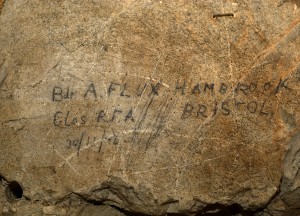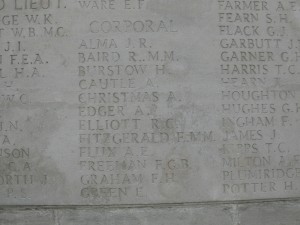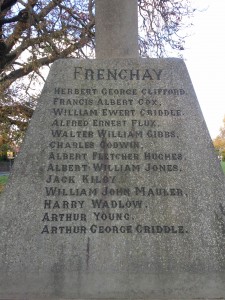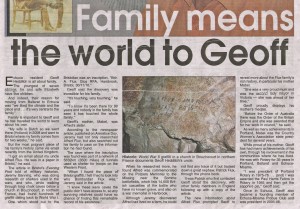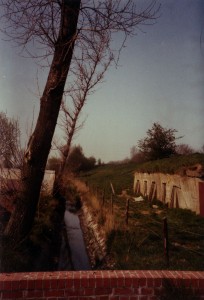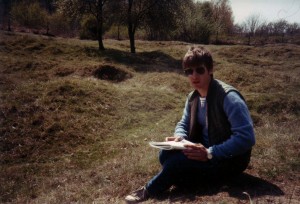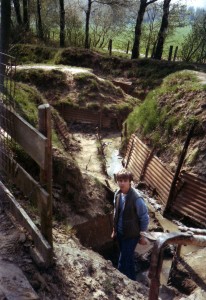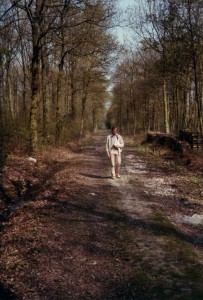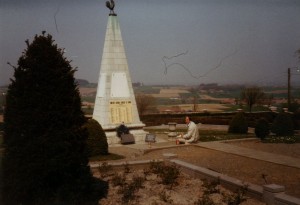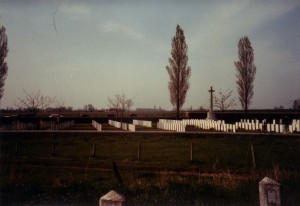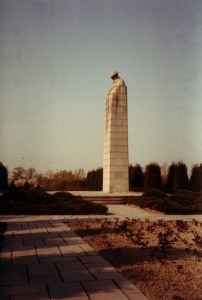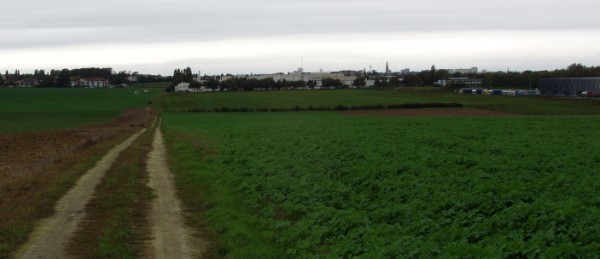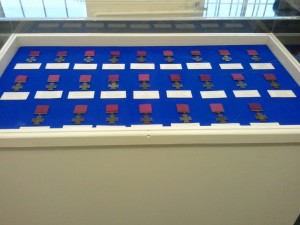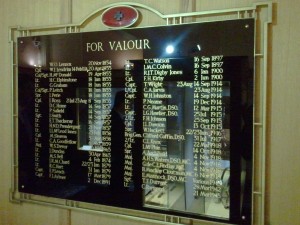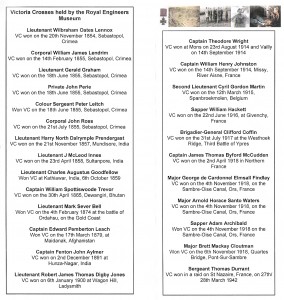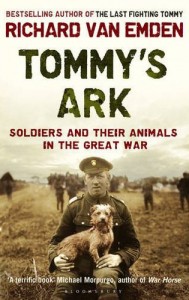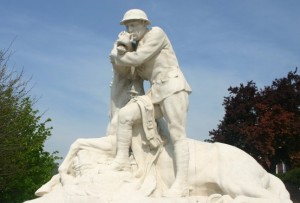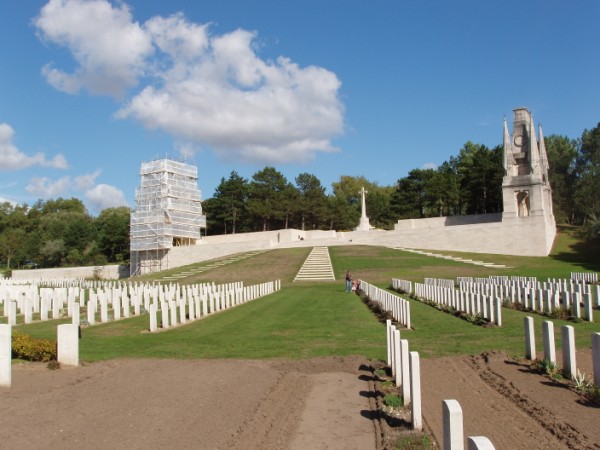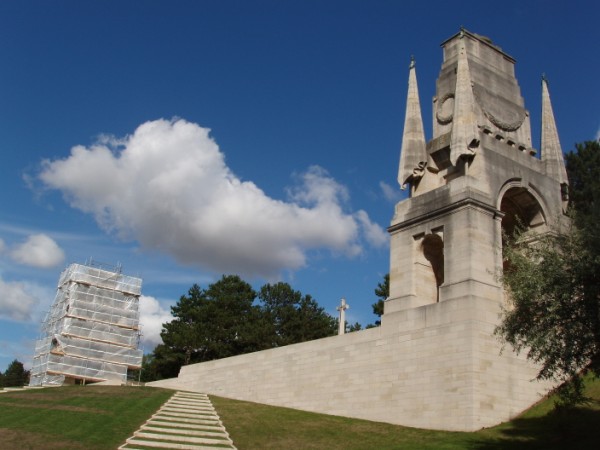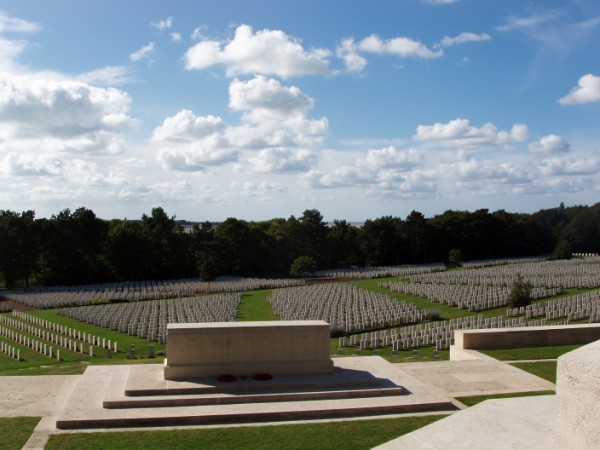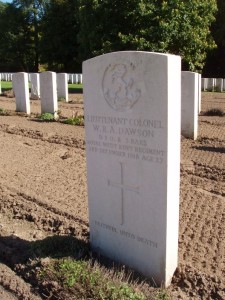Posts Tagged ‘Great War’
The Great War service of the Flux brothers from Hambrook, Bristol
I have been researching certain members of this family after I spotted some graffiti of a Great War soldier, Bombardier Alfred Flux from Hambrook, whilst exploring caves under the church in Bouzincourt on the Somme in May last year. Whilst the caves were covered in graffiti from soldiers from all over the world I was intrigued by this local man and endeavoured to find out more about him.
Full details of this can be found on the newspaper link below as the story was featured in the Armistice Day editions of the Bristol Evening Post, Western Daily Press and Bath Chronicle.
Alfred Flux
832011 Corporal Alfred Ernest Flux, serving with “Y” 61st Trench Mortar Battery, Royal Field Artillery was killed on 21 March 1918, aged 25. He was the son of Alfred William and Emily Flux, of Walton Farm, Hambrook, Bristol and is commemorated on the Pozières Memorial to the Missing.
Alfred had served in 1916 in the Laventie area with involvement in the Battle of Fromelles on 19/20 July 1916 and stayed in this sector until his Division moved south to the Somme in mid-November 1916. The war diary says they were billeted in caves under Bouzincourt Church on 28 November and the graffiti is dated 30 November. The Battery stayed at Bouzincourt until January 1917 and then they went back for rest. February 1917 saw a move to Harbonnieres, south of the River Somme until May 1917. By June 1917 the battery was near Arras and then moved up to the Ypres sector where they were employed as stretcher bearers for the 38th (Welsh) Division in the Canal Bank sector on the first say of the Third Battle of Ypres (Passchendaele). They stayed in the salient until September when they moved back down to the Arras front, holding the dreaded Chemical Works and Greenland Hill sectors for the next two and half months. They then moved down to the Somme area and in January 1918 were ensconced in the Holnon Wood sector west of St Quentin. It was whilst holding these positions against the German Spring Offensive on 21 March 1918 that Alfred Flux was killed.
Since the article being released I have been in further touch with members of the Flux family, notably Judith Pike (who lives in Bristol) and Geoff Hedditch from Echuca, Victoria in Australia. I had done a fair bit of research into the family so knew that Alfred was one of a family of five children but Judith explained that Alfred’s younger brother, Francis Charles (but known as Charlie until his death at the ripe old age of 86 years) had also served as an artilleryman in the Great War. I volunteered to find out as much of his service as I could and was able to produce a detailed report for the family. Luckily, Charlie’s service record had survived and so I could piece together his service with 47 Brigade, RFA and then various Trench Mortar Batteries of the 19th Division. Other than suffering from dysentery in 1915 he appears to have been unwounded and was demobbed in February 1919.
I was both amazed and delighted by the huge amount of detail you have unearthed. Your information has opened up that era in a fascinating way I never expected to happen. I would like to say a big thank you for your diligence in researching my grandfather, and of course, initially finding out so much about his brother Alfred. Thank you for all you have done to bring real colour into our family history, and I want to wish you every success with your work as a researcher of the Great War. Judith Pike, Frenchay, Bristol
I was delighted to receive some post this morning from Geoff Hedditch in Australia. Enclosed in the envelope was a copy of his local newspaper, the Riverine Herald, which included an article about Geoff and his delight at the work I had done. I would like to thank Patrick, Judith and Geoff (all members of the Flux family) and Alan Freke and his fine colleagues at Frenchay Village Museum for their help. It just goes to show what a spark of interest coupled with a bit of determination can achieve – quite amazing that this story could travel all the way to Australia.
Please also remember the Flux boys themselves – Alfred and Charlie – who both answered their country’s call when needed and who, for one, paid the ultimate price.
I have been sent some photos of a trip to the Ypres battlefields made in 1984. I was still in the second year of secondary school at this point so didn’t go along – the two intrepid travellers were my father and eldest brother, Mark (http://www.mgbtours.com/). For the both of them this was their first trip to any Great War battlefield. I am glad to say that it was certainly not their last – my father regularly visits both Ypres and the Somme with the rest of the Banning family and also with the wonderful Genesta Battlefield Club. As for Mark, he now spends his time as a full-time battlefield guide (and highly recommended he is too) so it is clear that this 1984 pilgrimage was the first of many visits to the hallowed ground of the Ypres salient.
These pictures, taken in the pre-digital era, have been scanned and tidied up by me. Ignoring the questionable fashions on display they show fascinating details of many oft-visited places around the immortal salient – all without the coaches of visitors that often accompany some of these spots nowadays.
Of particular interest are the shots of the Advanced Dressing Station on the banks of the Ieper-Ijser canal at Essex Farm Cemetery which show the site before its restoration in the 1990s. Modern shots can be seen by visiting this site. Visitors to the area can you buy ambien mexico will know of its association with John McCrae, author of ‘In Flanders Fields’.
Also worth noting are the low trees at the Brooding Soldier Memorial at Vancouver Corner. It is amazing how the horticulture and the inexorable work of nature has such an effect on the way a particular spot looks. It was this site that held their main interest as they remembered my grandfather, Private Seymour Henry Banning, 13th Battalion, CEF (Royal Highlanders of Canada) who was gassed and taken POW very close to the spot on or around 22 April 1915 – one of the first men ever to have been gassed in warfare.
Click on the pictures to see them at full size.
Many thanks to my brother Mark Banning for these photos.
I was lucky enough to be invited to the launch of the new Victoria Cross Gallery at the Royal Engineers Museum on 11 November. The exhibition opened to the public on 12 November but, along with about a hundred others, got a sneak preview. The exhibition celebrates the twenty five Victoria Crosses that the Museum holds as well as giving details for a further thirty RE VCs not in the museum collection. BBC Kent covered this story HERE.
Prior to the opening we were all lucky enough to see the ORIGINAL Victoria Crosses in a display box – I was informed that a cost estimate for the box was about £10 million.
It was terrific to see medals – from some of the earliest medal from the Crimean War, Boer War (Lieutenant Digby Jones who was the first man to be awarded the VC posthumously) through to the Second World War and that of Sergeant Thomas Durrant, awarded posthumously following his actions in the St Nazaire raid of 1942; his bravery was so great his captors insisted he receive a bravery award.
However, it was the Great War VCs that I had really come to see and I was not disappointed. Amongst those on display along with unseen archival material, personal items, and weaponry were the three Royal Engineers whose VC action was on the same day – 4 November 1918 when crossing the Sambre-Oise canal; Sapper Adam Archibald VC, 218 Field Company, Major George de Cardonnel Elmsall Findlay VC, MC & Bar, 409 (Lowland) Field Company and Major Arnold Horace Santo Waters VC, 218 Field Company.
Major James McCudden, Gillingham’s own VC recipient, whose medals are on display alongside those of his two brothers (who sadly both also died in WW1) and his father’s (who died shortly after WW1).
My main interest was to see an addition to the museum’s collection of the story of Sapper William Hackett. I had tracked down descendants of Thomas Collins, the man Willam Hackett refused to leave under the fields of Givenchy-lès-la-Bassée in June 1916. This BBC Wales news item shows the picture of Thomas that hung over his mother’s fireplace until her death. It had been arranged between the family descendants and the RE Museum that this picture would go to the museum – after all, Collins is instrumental to the Hackett’s VC action. I was delighted to see Terry Carroll there, nephew of Thomas Collins, who I had met at the Tunnellers Memorial unveiling in June. He was delighted and understandably moved to see the picture of Uncle Tommy, a picture he knew so well from his childhood, restored, cleaned and hanging in such illustrious company in the RE Museum.
There is a Remembrance book in the Medals room, specifically for people to record their memories of members of their family who have served in the armed forces. The exhibition is now open to all visitors – it is highly recommended. Well done to the museum staff who have done such a fine job with this exhibition. The braveryof the men who earned these awards is, as ever, staggering.
The museum can be found on Prince Arthur Road, Gillingham, Kent, ME4 4UG. Telephone 01634 822839 or website www.remuseum.org.uk
Animals in the Great War – new book out
Whilst at the National Archives last week I met up with Richard van Emden for a coffee and he gave me a copy of his latest book, Tommy’s Ark: Soldiers and Their Animals in the Great War. I had been eagerly waiting for this as I had done a good deal of research for Richard on this book about a year ago and wanted to see how this fitted into the finished product as well as look at the reams of material that Richard had found. I was delighted with what he and Bloomsbury have produced. The jacket cover is in the same style as that used for Richard’s recent books with the same publishers, The Last Fighting Tommy and The Soldier’s War and shows a small dog, Sammy, the mascot of the 1/4th Northumberland Fusiliers who travelled out to France with the battalion in April 1915, served at Ypres (where he was wounded and gassed), was buried by shellfire on a number of occasions and later served on the Somme. Just this description gives some idea of the strange and amazing stories that the book contains.
The publishers blurb desribes it thus:
“This book tells the story of all the creatures, great and small, that inhabited the strip of murdered earth that snaked hundreds of miles from the Belgian coast to the Swiss Alps. In all, 61 species are included here and within a few species, such as birds and butterflies, there are also a number of varieties: for example, 43 kinds of bird are noted. Some species are mentioned once, others on a number of occasions: these include spiders, maggots, canaries, chickens, owls, lions, turkeys, fish, horses, cats, ferrets, wasps and worms. However, just as importantly, this is not a book about wildlife in isolation from man. On the contrary, it is about the human condition in war, explored through the soldiers’ relationship with the natural world around them…”
Michael Morpurgo, author of War Horse, writes: “If ever you are in doubt about the devastation and universal suffering that war brings to us, and to all creatures, great and small, then read Tommy’s Ark”
I really cannot wait to get stuck into it as soon as my current read is finished. When Richard and I were discussing how the book would work we identified various potential pitfalls to overcome; the main one being to avoid repetition. Having found many thousands of words of quotes myself I know the variation there is regarding these animals. Subsequent conversations and a good look through the book has confirmed my thoughts – there are such a wide range of stories that the reader really won’t be disappointed. My favourites (from the ones I found) are the old lady keeping bees on the lower slopes of Vimy Ridge in 1916 and the officer who tried to smuggle his beloved dog ‘Teddie’ buy xanax 0.25 back to Blighty at the end of hostilities. The images are terrific too – monkeys, dogs and kittens in the trenches as well as a collection of exotic mascots including a full grown bear!
I am sure it will sell well, particularly in the UK, as we have such an affinity to animals. Witness recent news items with the reactions to any instances of animal cruelty – I have seen people get more upset over the welfare of animals than people! Even on battlefield visits the wonderfully moving 58th (London) Division Memorial at Chipilly with its depiction of a soldier comforting his wounded horse has reduced some visitors to tears.
A quick word about conducting research for the book. Richard asked me to help him in finding animal stories in letters, memoirs and diaries. When I worked on the IWM panorama books Somme, Passchendaele and Arras with Peter Barton research was relatively easy, albeit time consuming. I visited over twenty different regimental museums around the UK as well as the Liddle Archive and many countless days in the Department of Documents at the IWM. My research was always tailored to a battle so I could use the archive search facility (if they had one!) for e.g. Somme or Arras. I also had a good knowledge of battalions, brigades and divisions which had served in each battle so could focus my reading that way. However, searching for stories involved animals presented many challenges. Only the most obvious stories were included in any précis of a collection – these were secured straight away. Subsequent research was on a more ‘hit and miss’ nature. The IWM holds so much material but, from my time spent there, I knew that certain memoirs were better written than others or that the writer had a particularly inquisitive mind and keen eye. It was these that I began with and, more often than not, I was rewarded with an animal story. On occasions though I recall a hard afternoons speed reading of hundreds of pages of memoir, letters or diaries and nothing to show for it other than a headache and blurry eyes. I shudder to think how many words we read in order for Richard to get the requisite 100,000 words but it was all interesting stuff – the hardest part was not getting waylaid on other interesting stories that one came across.
I am sure that Bloomsbury will soon be pulling out all stops to promote the book so they don’t need any PR from me. However, for those interested further details of the book along with a collection of interviews and ephemera from veterans can be found on Richard’s new website: http://www.richardvanemden.com/
Just back from two days on the battlefields of Arras and the Somme – a top class trip. I thought it worth noting that I saw this new sign going up yesterday on the Pozieres-Thiepval road. As you come from Pozieres you will see a huge white barn on the left hand side – it is about 100 yards after the ‘Mouquet Farm 1km to go’ – the new banner is on the side of this barn. If you are coming from Thiepval, well, you won’t miss it…
I was at the Historial yesterday and am always impressed with the place. The Gas! Gas! Gas! Chemical Warfare exhibition is well worth a look and was very well done (it ends on 14 November). Let’s hope that the sign encourages some battlefield visitors to visit Peronne. I understand Thiepval Visitor Centre and the memorial gets about 150,000 visitors per annum and the Historial just over half of that. Those tens of thousands don’t know what they are missing – the museum really is top class and is only a hop and a skip from the British 1916 battle areas.
Click HERE for the Historial’s website.
Etaples Military Cemetery
On way back from family holiday in the Dordogne we stopped the final night at Le Touquet. Being so close to Etaples I couldn’t resist a visit to the huge military cemetery there, the largest in France with 11,479 casualties buried here. This is only marginally smaller than the number buried at Tyne Cot but I would venture it receives a fraction of the number – there were only a couple of other visitors whilst we were there. I have been a number of times before on battlefield trips and have always battled the rain and cold but was blessed with wonderful weather on Saturday. It looks like maintenance work is being carried out on the entrance structure and some areas were being resown with grass seed. It really is well worth a visit and is especially poignant that one can see the sea from the cemetery entrance. For so many men it was a case of so near and yet so far.
In fact, next time I am heading to the Somme I think I will take the A16 this way from Calais – via Wimereux and Etaples and then stopping at Montreuil to see where Sir Douglas Haig had his headquarters and then continue down to Amiens and into the battlefields that way. It is a fascinating route and surprisingly pretty too!
Whilst at Etaples I really wanted to pay my respects at the grave of Lt Colonel William Dawson, DSO & 3 Bars, 6th Queen’s Own (Royal West Kent Regiment) who is buried in XLV. A.10. Dawson was quite a man – I understand that he refused promotion above the level of battalion command and was entitled to wear seven wound stripes. He is mentioned in Alan Thomas’ wonderful book, ‘A Life Apart’. The one bit of that book that always struck me was when Thomas referred to Dawson’s bravery and reaction to shellfire. Sadly Dawson was hit by shellfire in October and died in December 1918. Truly a brave man.
Alan Thomas wrote:
I never believed in a man bearing ‘a charmed life’. If I had, I should have put Dawson high on the list. So, I think, would most of the battalion. For when you were with Dawson you felt safe. Often I walked by his side along the stickiest of roads and through the unhealthiest of trenches, and because he was with me I did not feel afraid. Had I been alone, I could scarcely have dared to creep along even on all fours. But he would stride buy generic alprazolam online ahead, with his pipe in his mouth, as confidently as if he had been walking down Bond Street. (As a matter of fact, he would never have been seen in Bond Street with a pipe on: his ‘West End’ standards would have seen to that.) Did he know what fear was? I often wondered. Then one day, in 1917, I came across him alone. Our lines were being heavily bombarded and I was going along my sector to see if the men were all right. Turning into one of the bays, I ran into Dawson. He was standing in an odd position: instead of leaning with his back to the side of the trench, he was standing facing it, gripping the mud wall with crooked fingers. His expression was drawn, as though he were in pain. On seeing me, he relaxed and tried to laugh. It was the laugh of a nervous, frightened man. I gazed at him, wondering what had happened. For a moment I thought he might have been wounded.
‘Are you hit, sir?’ I asked.
‘Hit?’ He repeated the word as though he did not know what I meant. Then he went on: ‘I suppose it’s never occurred to you that I could be frightened?’ He was looking at me squarely and had got possession of himself again. I said the idea had never occurred to me.
‘Do you think I like these bloody bombardments,’ he went on. I told him that I didn’t think that, either, but that I had never seen him afraid.
‘Well, you have now,’ he observed. ‘It was because I was afraid that I was clinging to this bloody trench.’
‘I don’t blame you,’ I said. ‘I’m frightened myself.’
‘But when I’m with other people,’ he said, ‘I don’t show the fear I feel, that’s all. Nor do you have to, either.’
‘No, sir,’ I said, feeling proud that he should seem to place me in the same category as himself: that is, the category of the really brave who feel afraid but do not show it.
‘But I don’t mind telling you now –’ he added, but evidently thought better of it, for he broke off and with a gruff, ‘Come on’, led the way along the trench in his usual confident way. And, walking behind him, I felt safe.
Well, that was Dawson – or some idea of him, at least.
Copyright: Alan Thomas, A Life Apart, Victor Gollancz, London, 1968.

